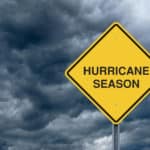Hurricane Preparedness Checklist for Business Owners: Before and After the Storm

When a hurricane approaches, you need to be prepared. This is true on a personal level, and requires collecting emergency supplies like battery-powered flashlights, first aid kits, and non-perishable foods. But for business owners, it’s also true on a professional level.
Having a proper hurricane preparedness plan for your business goes a long way in safeguarding your assets, protecting employee safety, and ensuring business continuity in the face of potential disruptions and damages caused by hurricanes.
This guide focuses on the essential steps to get your business’s building prepared, both inside and outside, before disaster strikes. Packed with valuable insights and practical tips, this toolkit is designed to empower large and small business owners alike with the knowledge and strategies needed to protect their assets, ensure employee safety, and maintain business continuity during the hurricane season.
When is Hurricane Season?
Hurricane season typically spans from June 1st to November 30th, though they may occur earlier or later in the year as well. Hurricanes typically affect Caribbean islands and North American states along the Atlantic coast and within the Gulf of Mexico.
Common Hazards Associated With Hurricanes
Hurricanes, as powerful natural disasters, bring three common hazards: high winds and tornadoes, flood waters, and electrical damage. These three hazards together can quickly cause severe structural damage and property losses.
Structural Damage & Property Losses
Hurricanes generate sustained winds starting at 74 mph (119 km/h), with Category 5 hurricanes reaching wind speeds of 157 mph or higher — with even stronger gusts. As hurricanes make landfall, their high winds can uproot trees, tear off roofs, shatter windows, and cause extensive structural damage to buildings and infrastructure.
In addition to the sustained winds, tornadoes spawned by hurricanes can inflict localized and concentrated destruction, adding to the overall wind-related hazards. Taking proactive measures such as reinforcing structures, securing loose items, and having proper insurance coverage can help mitigate the risk of structural damage and minimize property losses during hurricanes.
Flooding & Water Damage
The heavy rains that accompany hurricanes often result in widespread flooding as rivers, streams, and drainage systems become overwhelmed by the deluge. Additionally, the storm surge — a rise in sea level caused by the hurricane’s intense winds and low pressure — can push flood waters further inland, exacerbating the impact.
Flood waters can infiltrate homes, businesses, and infrastructure, leading to extensive water damage, structural instability, and the potential loss of personal belongings and business assets.
Power Outages & Electrical Damage
Due to hurricanes’ strong winds and heavy rains, trees and debris frequently fall down onto powerlines, leading to widespread electrical failures. Storm surges can also inundate electrical infrastructure, causing further disruptions. Extended power outages can result in a loss of essential services, including lighting, heating, cooling, and communication systems.
Further, electrical damage can occur to appliances and electronics due to power surges or water infiltration. It is crucial for individuals and businesses to utilize surge protectors and install backup power sources, such as generators, to safeguard business operations after the storm.
The Business Owner’s Hurricane and Tropical Storm Preparedness Checklist
Disaster preparedness is essential when it comes to safeguarding lives and property during severe weather events like tropical storms, hurricane watches, and hurricane warnings.
The following comprehensive hurricane safety checklist combines advice as provided by NOAA (NOAA.gov) and the National Weather Service (Weather.gov) to guide you through each stage of hurricane preparation and safety. You can also view our Hurricane Preparedness Guide for a day-by-day breakdown of what to prepare, when, in advance of the upcoming storm.
Stay Informed
Business owners must stay informed of the development of a possible or incoming hurricane to ensure the safety of employees and customers, make timely decisions regarding business operations and continuity, and take necessary steps to mitigate potential risks and damages.
- Monitor severe weather updates from reliable sources and follow guidance from local authorities regarding business operations and potential closures.
- Familiarize yourself and employees with evacuation routes and emergency shelter locations, and develop a plan for safely evacuating the premises if necessary.
Develop Business Continuity and Recovery Plans
Having a business continuity plan (BCP) in place prior to a natural disaster will ensure the continuity of critical operations, minimize disruptions, and protect the safety of employees and assets.
- Assess your business insurance policy to make sure it covers potential hurricane-related damages and losses. Consider adding flood insurance or business interruption coverage if applicable.
- Outline steps to resume operations after the storm, including remote work capabilities, alternative locations, and supplier contingency plans.
- Develop a recovery plan that outlines the steps and timeline for restoring operations, repairing damages, and resuming business activities.
Secure the Premises
By safeguarding the property, business owners protect their valuable business assets and prevent or mitigate potential damages.
- Assess windows, doors, and roofs, and make necessary repairs or reinforcements to assist in wind and water damage mitigation.
- Install storm shutters or reinforce windows with plywood sheets to protect against strong winds and flying debris.
- Place sandbags strategically around entrances and low-lying areas to divert or absorb floodwaters.
- Secure loose objects, signage, and outdoor furniture that could become projectiles during high winds.
Ensure Data & Equipment Safety
Storing data off-site and investing in generators or other tools can save critical business information, helping to get business operations back up and running quickly after the storm.
- Back up and securely store business data off-site or in the cloud to prevent loss in the event of power outages or equipment damage.
- Store hard copies of important documents, licenses, permits, and financial records in waterproof containers.
- Move valuable equipment, machinery, and inventory to higher ground to safeguard against water damage.
- Acquire emergency generators as needed, or test existing generators to ensure they remain in proper working condition and have enough fuel to provide power in case of utility outages.
- Install surge protectors to minimize electrical damage.
Maintain Communication
Keeping your employees, stakeholders, and customers informed of your operational status ensures everyone is on the same page during a chaotic time, and can help coordinate recovery efforts and minimize potential disruptions.
- Compile an emergency contact list of phone numbers and email addresses, including emergency services, local authorities, utility companies, and key employees.
- Communicate your business continuity plan with employees.
- Communicate any changes in business operations, business closures, or alternative work schedules.
- Communicate with suppliers to ensure the continuity of necessary resources and inform customers of any potential service disruptions or delays.
After the Storm: Hurricane Recovery for Business Owners
In the aftermath of a hurricane, it’s crucial for business owners to take immediate action. The steps detail exactly what you should do after a hurricane has hit, including checking in on employees, assessing damages, documenting losses, contacting insurance providers, and implementing recovery strategies to restore business operations effectively.
Activate Your Response Plan
- Get in touch with employees to ensure their safety and well-being.
- Conduct a thorough assessment of the premises for any immediate hazards or dangers, and make temporary repairs as able.
- Restore essential services such as power, water, communication systems, and internet connectivity, to facilitate business operations.
Assess and Document Damages
- Conduct a comprehensive assessment of property damages, taking photographs and documenting all losses for insurance claims and emergency assistance.
Secure Financial Resources
- Contact the Federal Emergency Management Agency (FEMA) and your insurance provider’s emergency response team to report damages and initiate the disaster recovery claims process.
- Explore available financial assistance programs, loans, grants, and other resources provided by government agencies and private organizations to support the recovery process.
Cleanup and Debris Removal
- Arrange for professional cleanup services to remove debris, hazardous materials, and damaged inventory, ensuring a safe and clean environment.
- Collaborate with local authorities and follow their guidance regarding safety protocols, permits, inspections, and any necessary certifications for reopening.
Communicate with Stakeholders
- Keep employees, customers, suppliers, and partners informed about the recovery progress, projected timelines, and any temporary changes to operations.
- Request emergency fuel delivery as needed to keep your business operational and serving the community.
Evaluate and Improve
- Conduct a post-recovery evaluation to identify areas for improvement in your response and recovery plans, and implement necessary measures to enhance future disaster preparedness.
What to Include in a Business Continuity Plan
A detailed business continuity plan can help ensure the continuity of business operations during and after a hurricane. Many BCPs include the following:
- Business Impact Analysis – an assessment of potential risks and their impacts on business functions, to prioritize critical operations and allocate resources effectively.
- Important Contact Information
- Employees
- Key stakeholders
- Utility companies
- Insurance companies
- Local emergency services
- Federal emergency aid
- Emergency Communication Procedures
- Copies of Insurance Policies
- Data & IT Backup Processes
- Steps for Resuming Operations
- Assessing structure & employee safety
- Backup power sources
- Remote work capabilities
- Alternative work locations
- Supplier contingency plans
- Regular BCP Review & Training
Plan for regular review of your BCP, continually updating emergency plans, contact information, and supplier details as needed. Then, schedule dates to provide training sessions for your employees, educating them on the details of your business’s emergency plan, and their responsibilities in the case of an emergency.



